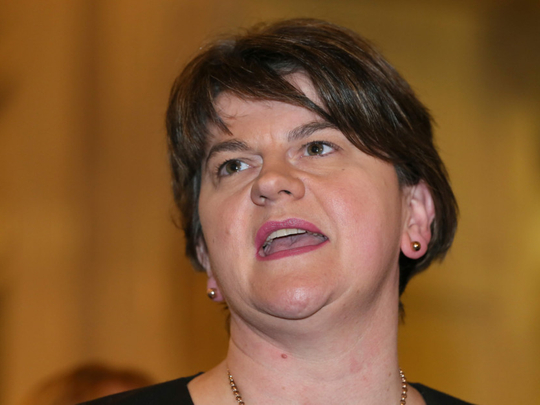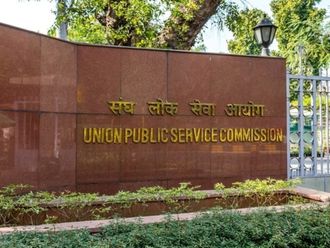
For the past 13 months, Northern Ireland has been without a working government, one that is representative of all the 1.8 million people who live there.
Under the terms of the Good Friday Agreement signed in 1998 between the governments in London and Dublin respectively — a deal that was brokered with the help of the administration of the then United States president Bill Clinton in Washington — and agreed to by Unionist and Nationalist parties alike, the British-ruled province was to be run by a power-sharing executive. This executive was to be made up of senior officials from the two largest parties acting as cabinet ministers, sitting around a cabinet table, led by a first minister and a deputy first minister.
The Good Friday Agreement ended more than three decades of political and sectarian violence that had claimed more than 3,600 lives and injured another 36,000. It was approved in a referendum by the province’s voters. In the Irish Republic to the south of the island, voters there also backed a referendum to give up the south’s constitutional claim over Northern Ireland. The island had been divided since 1921 when Britain granted independence to the south, but retained six of the 32 counties — a move that ensure that the Protestant Unionists, whose most ardent adherents belong to its Orange lodges, would have a majority there for the foreseeable future — the demographic reality of politics.
That is the theory.
The practise is far different — and that foreseeable future has suddenly become very blurry indeed.
The last power-sharing executive broke down in January 2017 in a row over the ballooning costs of a renewable energy scheme. The “cash-for-ash” scheme was supposed to offer rebates for homeowners and businesses burning greener fuel types. It sounded good on paper. It wasn’t. It turned out to be a licence to print money, and the costs of the scheme got out of control — so much so that it ended up costing Northern Ireland’s taxpayers £500 million (Dh2.56 billion). And the blame for this mess lay firmly in the lap of First Minister Arlene Foster. Foster is also the leader of the Democratic Unionist party, the largest party in the province and one that wants to maintain Northern Ireland’s place in the United Kingdom.
Sinn Fein is the second-largest party in the regional assembly and broadly represents a large minority of mostly Roman Catholics who want to re-unite Northern Ireland with the Republic. It was also the political arm of the Irish Republican Army, which was responsible for a large party of those deaths and injuries. Martin McGuinness, then the deputy first minister, had been an Irish Republican Army commander in Derry and made no secret of his past. But if peace is to break out, terrorists — or another man’s freedom fighters — need to be embraced.
McGuinness resigned over Foster’s handling of the cash-for-ash scheme, and the executive collapsed.
In early March, fresh elections were held for the Northern Ireland Assembly. So much for that Unionist majority foreseen in 1921. There were just 1,200 votes across the province between the Unionist and Nationalist parties, and the DUP (28) ended up with just one more seat than Sinn Fein (27) in the new 90-seat assembly.
The politics of the new demographics mean that in the not-too-distant future — and maybe even by the next time there is a vote for a new assembly — there is a very real chance that the Sinn Fein might have enough votes to become the largest party. And that could mean that a vote on the future of Northern Ireland as either part of the United Kingdom or with the Republic of Ireland would be on the agenda.
Naturally, any such vote would have to be approved by the government in London. But stranger things have happened — London did approve the referendum for Scotland’s independence in September 2015 — and we all know how that turned out.
And when it comes to politics and demographics in Northern Ireland, it sends 18 Members of Parliament to Westminster. The boundaries of those 18 constituencies guarantee that a majority will be from Unionist areas. And isn’t United Kingdom Prime Minister Theresa May ever so grateful of that?
No sooner had Northern Ireland’s voters elected a new assembly than — three and a half months’ later — they were voting in the UK general election called by May. Her Conservatives lost their majority, but remain in power now based solely on the 10 DUP MPs at Westminster in a confidence and supply arrangement.
A payment of £1 billion also helped.
That financial inducement was referred to police because some felt it was a bribe. But it also should be noted that some £400 million of it is earmarked for infrastructure spending — and mostly in those constituencies where there is a guaranteed Unionist vote.
Between the collapse of the assembly and earlier this month, six separate deadlines on forming a new power-sharing executive came and went. The main stumbling block was a demand from Sinn Fein that the new assembly pass a language rights act that recognised Gaelic — the original language spoken on the island, but one that was deliberately targeted by a succession of measures when Britain ruled Ireland. It is still spoken by about 2 per cent of the population on a daily basis in mostly remote western regions, but is taught at schools in the Republic.
The impasse over the language rights’ act appeared to have been ended two weeks ago when there was an agreement reached that there would be three separate bills — one that recognised Gaelic, one that recognised Ulster Scots, and one that guaranteed cultural heritage rights.
May, along with Ireland’s Taoiseach (Prime Minister) Leo Varadkar travelled to Belfast for the breakthrough.
Only there wasn’t one! Foster announced that there was no likelihood of a power-sharing agreement. That was a complete surprise to Sinn Fein, who then produced the apparent text of the supposed deal.
It turns out the rank-and-file membership of the DUP are very jittery now over that Gaelic language act. And that they see the writing on the wall too for the changing demographics.
The only advantage the DUP now has is its trump card at Westminster. Foster sees little reason to have to work with an assembly. If Northern Ireland must be governed directly from London, she’s in a perfect position to pull all the strings through her peddled influence with May.
Once before, in late last November, as European Union officials and London worked on the text of a deal for the first phase of Brexit talks, Foster exerted her authority — forcing a rework of working that guaranteed regulatory alignment between North and South when Britain leaves the European Union.
That’s the politics of the demographics for now. But who knows how long May will be in power? The clock is indeed ticking for her; for Foster and the DUP too.








